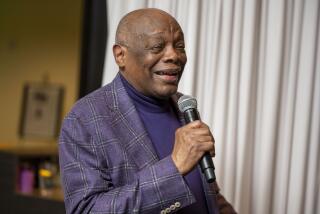Paul Brown, Innovator for NFL, Dies at 82 : Football: The founder of the Browns and Bengals systematized coaching, using new procedures to turn it into a science.
- Share via
Paul Brown, the veteran football coach who founded two of the NFL’s 28 clubs, died Monday at 82.
Known as the man who made football into a science, Brown had led the Cincinnati Bengals as coach or general manager since 1967.
Brown, who had been hospitalized last December for treatment of a blood clot in his leg, died at his home in the Cincinnati suburb of Indian Hill of complications of pneumonia, according to the Bengals. With him were his wife, Mary, and sons, Mike, the assistant general manager and legal counsel of the Browns, and Pete, the club’s director of player personnel.
Services were scheduled for Wednesday in Brown’s hometown of Massillon, Ohio.
Brown spent 25 years as a pro football coach, starting in 1946 with the Cleveland Browns, who were named for him by their first owner, Mickey McBride.
The Browns won all four championships in the All-America Football Conference, which was formed after World War II as a rival to the NFL.
In the 1950s, in their first six years in the NFL after a merger, Brown’s Browns played in six consecutive NFL title games, winning the first one and two others.
His disciples--Bill Walsh, Don Shula and Chuck Noll among them--have won 11 of the 25 Super Bowls. Fifty of his players have coached NFL teams.
Brown began his career as coach at Massillon High in 1930, when Knute Rockne was still at Notre Dame. Thereafter he spent most of his life in Ohio, founding both the Browns and Bengals before retiring from coaching in 1975.
Peers ranked him with Rockne, Vince Lombardi, Walsh, Shula and Frank Leahy in the profession’s top six.
In Brown’s last years, as part owner, vice president and general manager of the Bengals, he was a prominent NFL leader, identifying himself, for the most part, with two dominant ownership wings, the conservatives and the economizers.
He opposed instant replay officiating from the start, largely, his opponents complained, for economy reasons.
“I played for him eight years,” NBC announcer Bob Trumpy once said. “And he wore the same pants and shirt to training camp for eight years.”
Brown was widely known as a football innovator--as a play caller, for example. Years before other coaches followed suit with a practice that is universal today, he called every offensive play from the sideline, alternating messenger guards.
As long ago as the 1950s, seeking perfection in his messenger system, Brown bought a walkie-talkie and put a radio receiver in the helmet of his quarterback, George Ratterman.
But static and other interference, including police calls, kept jamming the football calls.
Finally, at Yankee Stadium one afternoon, Ratterman pulled off the buzzing helmet, called time and walked over to Brown. Visibly shaken, he said: “Coach, some guy just got stabbed over on Fifth Avenue.”
Brown’s other innovations were more durable.
During a career in which he won 351 games, or 70% of his starts--finishing with an NFL record of 170-108-6--he was credited with more contributions than anyone else.
“Whether they know it or not, nearly everyone in the game of football has been affected by Paul Brown,” former Commissioner Pete Rozelle told the Associated Press. “His wealth of ideas changed the game.”
Brown reportedly was the first in pro football with, among other things:
--Play books.
--Intelligence tests.
--Classroom teaching techniques.
--A year-round, full-time staff of assistants.
--Comprehensive game plans.
--A player grading system based on film clips.
--Taxi squads.
Moreover, Brown played a role in the scientific development of the forward pass, joining Hall of Famer Sid Gillman and two other former Ram coaches, Clark Shaughnessy and Hampton Pool, in creating the modern game. “To succeed in pro football, you have to do one thing first,” Brown once said. “You have to surround yourself with (assistant coaches) who understand the forward pass--who are in the forefront of the continuous evolution of passing.”
Slender and wiry, Brown was a sharp-eyed, sharp-faced man who often dressed in natty ensembles of his favorite color, brown. And like former coaches Bear Bryant and Tom Landry, he invariably wore a hat when on the sideline, seeming always to be about to leave for a board of directors meeting at a bank.
Personally, he was somewhat aloof as well as painstaking.
His preferred word for himself was meticulous.
In 1941, shortly before Brown accepted a coaching offer at Ohio State--which led to a wartime assignment as coach of the Great Lakes Navy team and thence to pro football--his doctors advised him to avoid big-time sports because, they said, he was “wound too tight.”
He once remarked that he--and his teams--reflected the personality of his father, a railroad man whose orderly habits prompted his promotion to a position as dispatcher for one of the rail lines that ran through Massillon.
Massillon in that era was recognized as the Midwest’s most rabid high school football community, and although small for a football player, Brown, one of the smartest kids in his grade, was attracted to the game.
He liked to say that he learned both quarterbacking and humility at Massillon. He once fell ill before an opening kickoff, then, worrying about the fate of the team without him, he got even sicker as they carried him home.
At halftime they rushed him the news on his sickbed: Massillon was leading, 47-0. His recovery was prompt.
Brown went on to play quarterback at Miami of Ohio, where he won a bachelor’s degree before getting a master’s at Ohio State. But he never forgot that even football can be taken too seriously.
“I don’t understand these coaches who live in their offices,” he said. “If you work after 7:30 or 8 at night, you can’t be fresh in the morning, and everyone is more creative in the morning, after a good night’s sleep.”
He said he slept a full eight hours every night in the 10 years that his Cleveland teams dominated.
“Paul organized the Browns at the AAFC’s request,” said Gillman, a fellow Ohioan. “That was the year the Rams left Cleveland for L.A..”
Brown was fired by a new Cleveland owner, Art Modell, in 1963 and refused all other jobs until he organized the Bengals in 1967.
Along the way, he developed Jim Brown, Otto Graham, Marion Motley, Lou Groza and eight others who join him in the Hall of Fame.
Motley, recalling Brown’s extensive use of game films, recalled players living in dread fear of the Monday morning movie sessions.
“I remember Dub Jones once scored five touchdowns against Chicago and the next day Paul didn’t find anything right with him,” Motley told the AP.
“He would pick out one guy and show every little thing he did wrong. Then he would turn the lights on, because he wanted to look the guy right in the eye.”
From time to time, Brown used to fret about overemphasis on winning. But each time he concluded: “The problem is, there’s just no other way to measure success in football.”
Nor did he apologize for the three-quarters of a century he spent in a child’s game.
“Do you want to call it miniature war?” he asked one day. “Or chess in hip pads? Whatever. Football is absorbing, exciting, intriguing. It’s a man’s life.”
More to Read
Go beyond the scoreboard
Get the latest on L.A.'s teams in the daily Sports Report newsletter.
You may occasionally receive promotional content from the Los Angeles Times.










